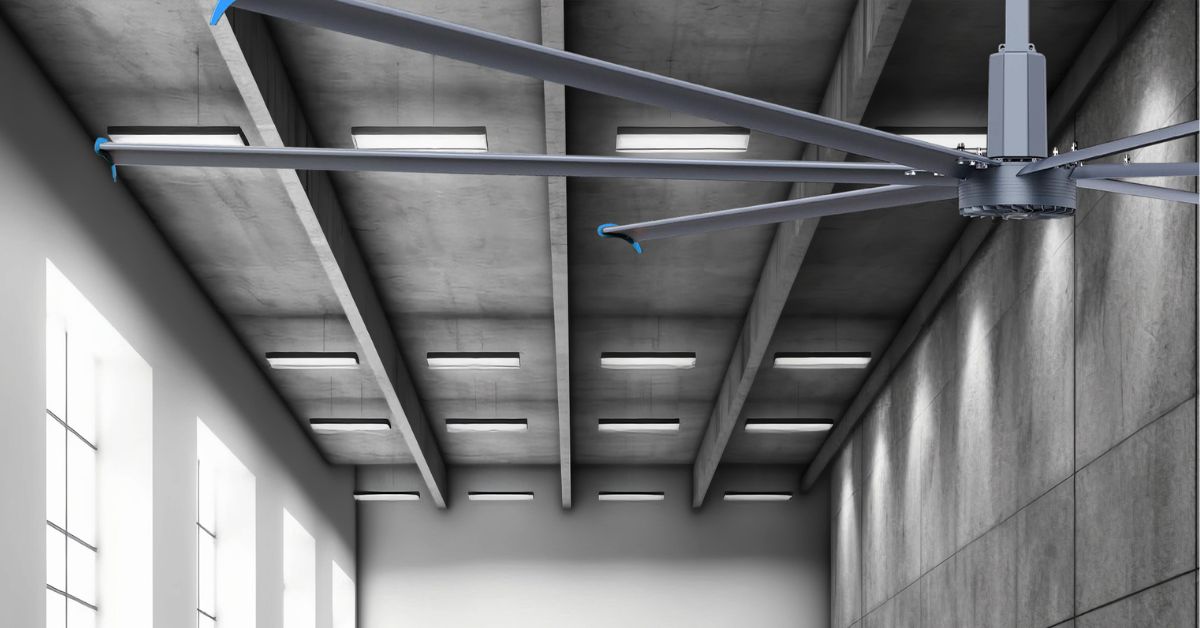Revolutionizing Airflow Efficiency with High Volume Low Speed Fans
In today’s industrial and commercial environments, maintaining optimal airflow and temperature control is more important than ever. One innovative solution gaining widespread attention is the High Volume Low Speed Fan (HVLS fan). Designed for energy efficiency and maximum air distribution, these fans have transformed how businesses manage indoor air quality. Whether it’s a warehouse, gymnasium, factory, or even a retail space, HVLS fans are becoming an essential part of modern climate control systems.
What is a High Volume Low Speed Fan?
A High Volume Low Speed Fan, often abbreviated as HVLS, is a type of mechanical fan that operates at low rotational speeds but is capable of moving a large volume of air. Unlike conventional ceiling fans that spin rapidly and cover small areas, HVLS fans have diameters ranging from 7 to 24 feet and are designed to move massive amounts of air gently and evenly throughout a large space.
These fans are especially beneficial in spaces with high ceilings where standard ventilation methods fall short. Their wide blades turn slowly, minimizing energy usage while still generating a large airflow. The result is improved air circulation, reduced heat stress for workers, and even lower air conditioning costs.
The Science Behind HVLS Fans
HVLS fans work based on the principle of “destratification.” In buildings with high ceilings, hot air naturally rises and cool air remains near the ground. This temperature imbalance not only makes the space uncomfortable but also leads to higher energy costs. HVLS fans gently push the warm air down and mix it with cooler air, balancing the temperature from floor to ceiling.
This gentle but consistent movement of air also helps in controlling humidity, dispersing smoke or odors, and improving overall indoor air quality. Unlike traditional fans that may create turbulence and noise, HVLS fans provide a smooth, consistent breeze with minimal sound pollution.
Benefits of Using HVLS Fans
1. Energy Efficiency
One of the primary advantages of using a High Volume Low Speed Fan is its ability to reduce energy consumption. These fans are designed to work in tandem with HVAC systems, allowing businesses to increase thermostat settings without compromising comfort. By improving air distribution, HVAC units do not have to work as hard, leading to substantial energy savings.
2. Enhanced Comfort
Employees working in large warehouses or factories often suffer from heat stress during warmer months. HVLS fans help regulate indoor temperatures, creating a more comfortable working environment. In commercial spaces like gyms or retail stores, the consistent breeze makes for a pleasant experience for customers and staff alike.
3. Cost Savings
Though the initial investment in HVLS fans may be higher than traditional fans, the long-term savings in energy bills and HVAC maintenance costs more than justify the expenditure. Additionally, the lifespan of these fans tends to be longer due to their durable design and low operating speed.
4. Eco-Friendly Solution
HVLS fans contribute to reducing carbon footprints. By decreasing the reliance on energy-hungry HVAC systems, businesses can meet sustainability goals while still maintaining operational efficiency.
Applications of High Volume Low Speed Fans
The versatility of HVLS fans makes them suitable for a wide range of industries:
-
Warehouses and Distribution Centers: These spaces benefit the most from improved air circulation, which helps protect both workers and inventory.
-
Manufacturing Facilities: HVLS fans mitigate the risk of overheating machinery and reduce heat stress for employees.
-
Agricultural Buildings: In barns or greenhouses, these fans maintain consistent air quality and help control odors and moisture.
-
Gymnasiums and Sports Arenas: Provide athletes and spectators with a comfortable environment by regulating temperature and airflow.
-
Retail Spaces: Enhance the customer experience by maintaining a pleasant indoor climate.
Key Features to Look for in an HVLS Fan
When selecting a High Volume Low Speed Fan, several features are critical to ensuring the best performance and longevity:
-
Blade Design: Look for aerodynamic blades that can move air efficiently with minimal resistance.
-
Motor Type: Direct-drive motors are generally more efficient and quieter than traditional geared motors.
-
Control System: Advanced fans come with smart controllers that allow integration with building automation systems.
-
Material Quality: Durable materials like aluminum or high-grade steel ensure the fan can withstand tough industrial conditions.
-
Safety Features: Redundant safety mechanisms like guy wires, safety clips, and automatic shutdown sensors should be standard.
Maintenance and Installation Considerations
While HVLS fans require less maintenance than traditional fans, regular inspections are still important. Bearings should be checked, blades cleaned, and all safety components inspected periodically to ensure optimal performance.
Installation should always be handled by trained professionals. Proper placement is essential to maximize airflow coverage and ensure safe operation. The fan’s location, mounting height, and surrounding obstructions should all be considered during installation planning.
Why Businesses in Singapore Are Adopting HVLS Fans
In Singapore’s hot and humid climate, the demand for efficient cooling solutions is high. A High Volume Low Speed Fan is ideal for the tropical environment, offering a cost-effective way to combat heat without relying solely on air conditioning. Businesses in Singapore are increasingly recognizing the benefits of HVLS fans for both comfort and energy efficiency, making them a popular choice across many sectors.
From logistics companies in Jurong to fitness centers in Orchard Road, HVLS fans are becoming a staple in modern infrastructure. Their ability to adapt to different environments and requirements makes them a smart investment for businesses aiming to improve working conditions while reducing operational costs.
The Future of HVLS Fan Technology
With ongoing advancements in technology, HVLS fans are expected to become even more efficient and versatile. Innovations such as variable frequency drives (VFD), integration with IoT systems, and solar-powered options are on the horizon. These developments will further solidify HVLS fans as a cornerstone of modern energy-efficient building design.
Manufacturers are also focusing on aesthetics, making these fans suitable not just for industrial but also high-end commercial and residential spaces. As awareness grows, the use of High Volume Low Speed Fans will likely extend beyond traditional applications.
Conclusion
The adoption of High Volume Low Speed Fans represents a smart move for any business looking to improve airflow, reduce energy consumption, and create a more comfortable environment. With their ability to move large volumes of air using minimal energy, HVLS fans are setting a new standard in ventilation and climate control. Whether you’re operating a factory, gym, or retail store, investing in an HVLS fan can lead to long-term benefits in comfort, cost, and sustainability.
If you’re in the market for an efficient and eco-friendly air circulation solution, now is the time to consider the advantages of a High Volume Low Speed Fan. It’s a game-changing technology that is shaping the future of indoor air management.







